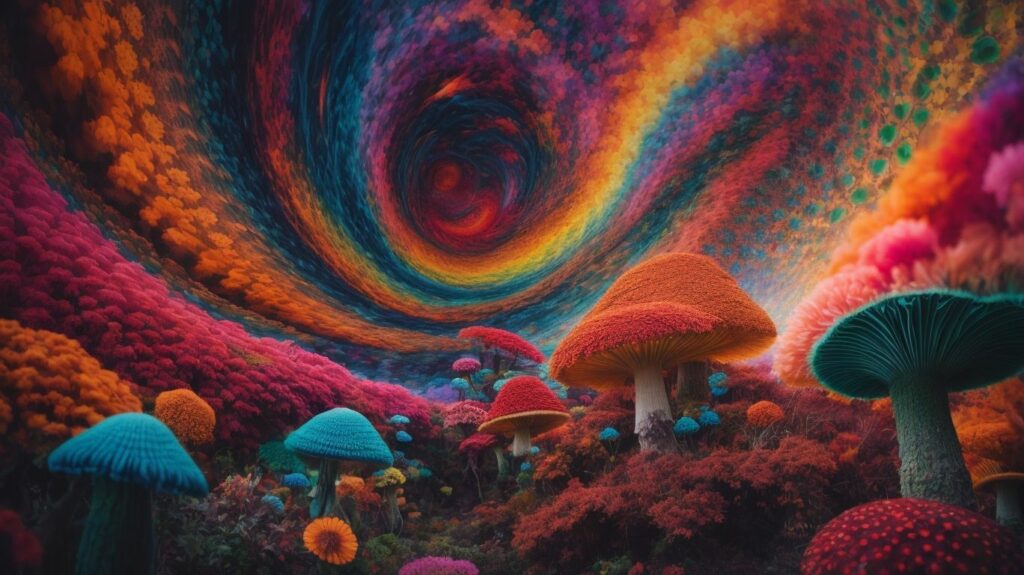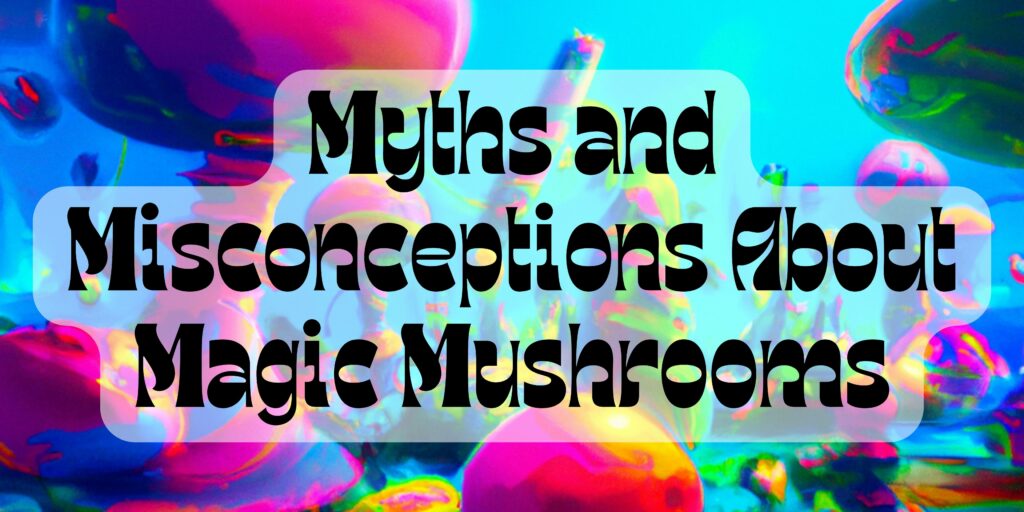Are you curious about the effects of LSD and magic mushrooms? Both of these psychoactive substances have gained popularity in recent years, but there are still many misconceptions and concerns surrounding their use. In this article, we will explore the similarities and differences between these two drugs, and address any worries you may have about their effects.
What Are LSD and Shrooms?
LSD and shrooms are both hallucinogenic drugs that alter perception, mood, and cognition. LSD, also known as acid, is a synthetic compound derived from ergot fungus. It is typically consumed in the form of small paper squares (blotter) or liquid drops. Shrooms, or magic mushrooms, contain the psychoactive compound psilocybin and are naturally occurring fungi. They are usually ingested orally, either raw or dried.
Both LSD and shrooms can induce intense visual and auditory hallucinations, as well as significant changes in thinking and emotions. It should be noted that these substances are illegal in many countries and can have severe psychological impacts.
How Do They Work?
LSD and shrooms, also known as magic mushrooms, interact with the serotonin receptors in the brain to induce their effects. Here is a step-by-step breakdown of how they work:
- Both LSD and shrooms contain psychedelic compounds known as hallucinogens.
- When consumed, these compounds are processed by the body and enter the bloodstream.
- They then travel to the brain and attach to serotonin receptors.
- This binding alters the function of serotonin, a neurotransmitter responsible for regulating mood, perception, and cognition.
- As a result, LSD and shrooms can cause changes in perception, mood, and consciousness.
- These effects can include hallucinations, altered thinking, and heightened sensory experiences.
Understanding the mechanisms of these substances is crucial for individuals considering their use and for researchers studying their potential therapeutic benefits.
What Are the Effects of LSD?
LSD, also known as acid, is a powerful hallucinogenic drug that can produce a wide range of effects on the mind and body. In this section, we will discuss the various effects of LSD, including sensory distortions, altered perception of time, and changes in mood and emotions. Understanding these effects is crucial in comprehending the overall experience of using LSD and its potential impact on the user. Without further ado, let’s dive into the world of LSD and its fascinating effects.
1. Sensory Distortions
Sensory distortions are a common effect of both LSD and shrooms, causing alterations in perception and sensory experiences.
- Visual distortions: Both LSD and shrooms can induce hallucinations, such as vibrant colors, geometric patterns, or distorted shapes.
- Changes in auditory perception: Users may experience heightened or distorted sounds, or even perceive sounds that are not present.
- Altered tactile sensations: Sensations such as a heightened sense of touch or a feeling of detachment from one’s body may occur.
- Changes in taste and smell: Users may also experience unusual or intensified flavors and scents.
You might lose track of time, but at least you’ll have a trippy experience to look back on.
2. Altered Perception of Time
Altered perception of time is a common effect of both LSD and shrooms. Here are the steps to understand this phenomenon:
- Time dilation: Both substances can cause a change in the perception of time, making it feel slower or faster than it actually is.
- Subjective experiences: Users may experience a stretching or looping of time, leading to a distorted sense of duration.
- Intensified moments: Ordinary experiences may become more vivid and meaningful, creating a sense of timelessness.
Historically, the altered perception of time has been documented in various cultures during spiritual rituals involving hallucinogenic substances. These experiences have influenced art, music, and philosophy, providing unique perspectives on the nature of time and consciousness.
3. Changes in Mood and Emotions
When consuming LSD or shrooms, the effects on mood and emotions can be profound. Here are some steps to consider:
- Prepare your mindset: Approach the experience with a positive and open mindset to enhance your emotional journey.
- Set and setting: Create a comfortable and safe environment to minimize negative emotions and maximize positive ones.
- Embrace the journey: Accept that changes in mood and emotions may occur and allow yourself to explore and process them.
- Reflect and integrate: After the experience, take time to reflect on the emotions you encountered and integrate any insights or lessons into your daily life.
Remember, everyone’s experience is unique. If you have any concerns or questions, consult a professional or experienced guide.
What Are the Effects of Shrooms?
The use of magic mushrooms, also known as shrooms, has gained popularity in recent years for its reported mind-altering effects. In this section, we will dive into the specific effects that shrooms have on the mind and body. From visual distortions to emotional and spiritual experiences, we will explore the various ways in which shrooms can impact one’s perception and thought patterns. By understanding these effects, we can gain a deeper understanding of the potential benefits and risks of consuming shrooms.
1. Visual Distortions
Visual distortions are a common effect of both LSD and shrooms. Here are some steps to understand and navigate this experience:
- Prepare Mentally: Educate yourself about the potential visual effects and understand that they are temporary and part of the psychedelic experience.
- Create a Safe Environment: Choose a comfortable and familiar setting where you feel secure and can relax.
- Start with a Low Dose: Begin with a small dose to gauge your sensitivity to visual distortions and gradually increase if desired.
- Observe and Accept: Embrace the visual changes without resistance or fear. Allow your mind to explore and appreciate the unique perceptions.
- Focus on the Positives: Use the visual distortions as an opportunity for introspection, creativity, and self-reflection.
- Stay Grounded: Maintain a connection to reality by reminding yourself of your surroundings and engaging in grounding techniques like deep breathing or physical movement.
- Seek Support: If the visual distortions become overwhelming or distressing, reach out to a trusted friend or sitter for guidance and reassurance.
2. Changes in Perception and Thought Patterns
When consuming LSD or shrooms, individuals may experience profound changes in perception and thought patterns. These alterations can be intense and may vary from person to person. Here are some steps to consider:
- Prepare your environment: Create a safe, comfortable, and familiar space to minimize potential anxiety or discomfort.
- Be in a positive mindset: Approach the experience with an open and positive mindset to enhance the potential for insightful and meaningful experiences.
- Start with a low dose: Begin with a low dose to gauge your body’s reaction and gradually increase the dosage if desired.
- Set intentions: Establish clear intentions and goals for the experience to guide your thoughts and reflections.
- Engage with your surroundings: Observe and appreciate the details of your environment, as perception may be heightened.
- Reflect and integrate: After the experience, take time to reflect on the changes in perception and thought patterns, and integrate them into your daily life.
Buckle up for a trip to the depths of your soul with shrooms, or take a shortcut with LSD – either way, you’ll come out feeling like a changed person.
3. Emotional and Spiritual Experiences
When using LSD or shrooms, individuals may have profound emotional and spiritual experiences. To enhance these experiences, here are some steps to follow:
- Set and Setting: Create a comfortable and safe environment that promotes relaxation and introspection.
- Mindful Preparation: Engage in activities that facilitate introspection and self-reflection, such as meditation or journaling.
- Intention Setting: Clarify your intentions for the experience, whether it’s personal growth, spiritual exploration, or emotional healing.
- Guided Experience: Consider having a trusted and experienced guide to support and navigate the journey.
- Integration: After the experience, take time to reflect, process, and integrate the insights gained into your daily life.
Remember, emotional and spiritual experiences can be deeply personal, so it’s important to approach them with respect, openness, and self-care.
How Are LSD and Shrooms Similar?
While LSD and shrooms are often seen as different types of psychedelics, they also share many similarities. In this section, we will explore the commonalities between these two substances, including their similar effects on perception and the potential risks and side effects that come with their use. By understanding these similarities, we can gain a better understanding of the overall effects of these psychedelic drugs.
1. Similar Effects on Perception
LSD and shrooms both have similar effects on perception, creating a distorted sensory experience. Here are the steps to understand these effects:
- Visual distortions: Both substances can cause hallucinations and alterations in visual perception.
- Changes in thought patterns: They can lead to abstract thinking, unusual connections, and a sense of interconnectedness.
- Altered sense of time: Time may feel stretched or compressed, making minutes feel like hours or hours feel like minutes.
Fact: Both LSD and shrooms interact with serotonin receptors in the brain, leading to their hallucinogenic effects.
Just like eating too many tacos, taking too much LSD or shrooms can lead to a wild and potentially uncomfortable ride.
2. Similar Risks and Side Effects
Similar risks and side effects can be associated with the use of both LSD and shrooms. Here is a list of steps to consider:
- Psychological effects: Both substances can induce hallucinations, anxiety, paranoia, and confusion.
- Physical effects: Users may experience an increased heart rate, elevated blood pressure, and dilated pupils.
- Bad trips: Both LSD and shrooms can trigger intense negative emotions, potentially leading to a distressing and overwhelming experience.
- Flashbacks: Both substances have the potential to cause flashbacks, where individuals may re-experience the effects of the drugs long after using them.
- Risks and precautions: Both LSD and shrooms can have unpredictable effects on individuals, and their use is associated with certain risks. Precautions should be taken to ensure safety and minimize potential harm.
Throughout history, hallucinogens like LSD and shrooms have been prevalent for centuries, with indigenous cultures incorporating them into spiritual and religious practices. However, it is important to approach the use of these substances with caution and respect for their potential risks and side effects.
How Are LSD and Shrooms Different?
While both LSD and shrooms are hallucinogenic drugs that can alter one’s perception and consciousness, they differ in several ways. In this section, we will uncover the distinctions between these two substances by examining their chemical composition, the duration of their effects, and their legal status. From the molecular level to the societal perspective, we will explore how LSD and shrooms diverge in their properties and use.
1. Chemical Composition
The chemical composition of LSD and shrooms sets these hallucinogenic drugs apart. Here is a list explaining their composition:
- LSD: The chemical name for LSD is lysergic acid diethylamide. It is a synthetic compound derived from ergot fungus.
- Shrooms: Shrooms, also known as psilocybin mushrooms, contain the compound psilocybin. Psilocybin is a naturally occurring psychedelic compound found in certain mushroom species.
LSD was first synthesized in 1938 by Swiss chemist Albert Hofmann. Psilocybin mushrooms have been used for centuries by indigenous cultures for spiritual and medicinal purposes. In the 1950s and 1960s, both LSD and shrooms gained popularity in Western counterculture movements. Today, they continue to be used recreationally and studied for potential therapeutic benefits.
2. Duration of Effects
The duration of effects is a crucial aspect to consider when comparing LSD and shrooms. Here are the steps to understand their differences:
- LSD: The effects of LSD typically last between 6 to 12 hours, with the peak occurring around 4 to 6 hours after ingestion.
- Shrooms: The effects of shrooms usually last between 4 to 6 hours, with the peak occurring around 2 to 3 hours after ingestion.
- Duration can vary depending on factors such as dosage, individual metabolism, and tolerance levels.
- It’s important to note that both LSD and shrooms can have lingering effects, such as changes in perception and mood, for several days after use.
True story: A friend of mine tried LSD for the first time and was surprised by the duration of its effects. He didn’t expect the trip to last for almost 10 hours, but he embraced the experience and found it to be transformative. He was grateful for the extended duration as it allowed him to delve deep into introspection and gain valuable insights.
3. Legal Status
The legal status of LSD and shrooms varies by country and jurisdiction. It is important to be aware of the legal implications before considering the use of these substances. Here are some steps to understand the legal status:
- Research: Familiarize yourself with the laws and regulations surrounding psychedelic substances in your specific location.
- Consult: Seek advice from legal professionals or organizations specializing in drug policy and legislation.
- Consider Risks: Evaluate the potential consequences, such as legal penalties or criminal charges, associated with the possession, distribution, or use of LSD and shrooms.
- Stay Informed: Stay updated on any changes or updates in drug laws and regulations.
- Alternative Options: Explore legal alternatives for achieving similar experiences or effects.
Which One Should You Choose?
When it comes to psychedelics, two substances that often come to mind are LSD and magic mushrooms (also known as shrooms). Both have been used for centuries for their mind-altering effects, but which one is the right choice for you? In this section, we will discuss the various factors that can influence your decision between lsd and shrooms. These include personal preference, the purpose of use, and the availability and legality of each substance. By considering these factors, you can make an informed decision that aligns with your needs and values.
1. Personal Preference
When choosing between LSD and shrooms, personal preference plays a crucial role. To determine your preference, follow these steps:
- Research: Educate yourself on the effects, risks, and experiences of both substances.
- Consult: Seek advice from individuals who have tried both LSD and shrooms to gain valuable insights.
- Reflect: Consider your own mindset, personality, and comfort level with hallucinogens.
- Goals: Determine your intentions for using psychedelics, whether it be for self-exploration or recreational purposes.
- Legality: Research the legal status of these substances in your country or region.
- Availability: Assess the accessibility and availability of LSD and shrooms in your area.
- Experiment: If possible, start with a low dosage of both substances to see which one resonates better with you.
What’s your purpose? Tripping or finding yourself, LSD and Shrooms have got you covered.
2. Purpose of Use
When considering the use of LSD or shrooms, it is important to understand your purpose for using these substances. Here are some steps to help you determine your purpose:
- Educate yourself: Learn about the effects, risks, and potential benefits of LSD and shrooms.
- Reflect on your intentions: Consider if you are seeking personal growth, spiritual experiences, or recreational use.
- Consult with experts: Talk to knowledgeable individuals, such as therapists or experienced users, to gain insights and perspectives.
- Assess your mental health: Evaluate your mental well-being and determine if you are in a stable state to handle the effects of these substances.
- Consider the legality: Understand the legal status of LSD and shrooms in your location and the potential consequences.
3. Availability and Legality
When considering the availability and legality of LSD and shrooms, it’s important to thoroughly research and understand the laws and regulations in your specific location.
- Check local laws: Research the availability and legality of LSD and shrooms in your country, state, or province.
- Consult legal resources: Seek information from reliable sources such as government websites or legal professionals to fully understand the specific laws and potential penalties.
- Consider medical use: In some instances, the medical use of LSD or psilocybin (the active component in shrooms) may be permitted under certain conditions.
- Be cautious with legal grey areas: Some substances may have an ambiguous legal status or fall into legal grey areas, so it’s crucial to exercise caution and stay informed.
- Understand the risks: Even if substances are legally available, it’s essential to be aware of the potential risks and side effects associated with their use.
Frequently Asked Questions
What is the difference between LSD and shrooms?
Both LSD and shrooms are psychedelics that can cause hallucinations, but they have different chemical structures and effects on the brain. LSD is a synthetic drug, while shrooms (or magic mushrooms) come from a specific type of fungi.
Which one has a longer duration of effects?
LSD typically has a longer duration of effects, with users reporting effects lasting up to 12 hours or more. The effects of shrooms usually last around 6 hours.
What are the potential risks and side effects of LSD and shrooms?
Both LSD and shrooms can have strong effects on the mind and should be used with caution. Some potential risks and side effects include anxiety, panic attacks, and changes in perception. It’s important to use these substances in a safe and controlled environment.
Which one is more commonly used?
LSD is more commonly used than shrooms, with a larger market for its production and distribution. However, the use of shrooms has been increasing in recent years.
Is one more addictive than the other?
Neither LSD nor shrooms have been found to be physically addictive. However, some users may develop a psychological dependence on the drugs and feel the need to use them regularly.
Are LSD and shrooms legal?
In most countries, both LSD and shrooms are illegal and classified as Schedule I drugs. However, some countries have decriminalized the use of shrooms for medicinal or therapeutic purposes.




